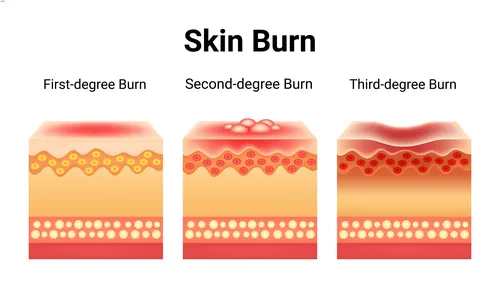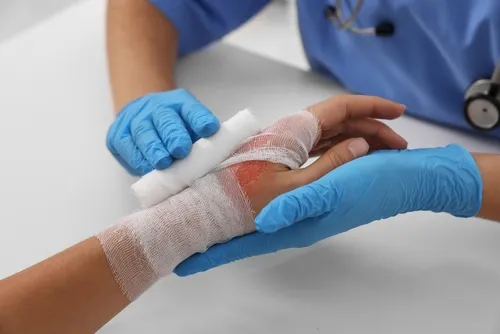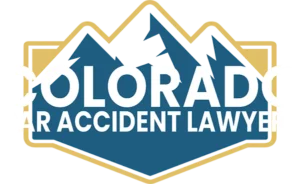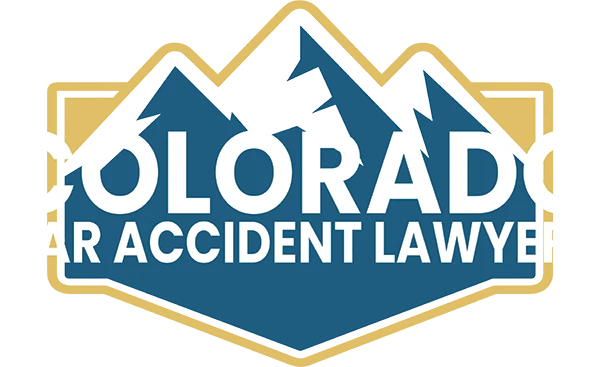Suffering a burn injury in a car accident can be a life-altering experience. Burns are among the most painful injuries, often requiring extensive medical treatment, rehabilitation, and long-term care. Victims of car crashes, truck accidents, and motorcycle accidents in Denver and throughout Colorado may be entitled to compensation for their injuries if another party’s negligence caused the accident.
Our law firm is committed to helping burn injury victims secure the financial recovery they need to move forward with their lives. Contact our Colorado car accident lawyers today for a free consultation!
Degrees of Burn Injuries
Burn injuries are classified into different degrees based on the severity of tissue damage. The classification of burns helps medical professionals determine the appropriate treatment and necessary interventions.
First-Degree Burns
First-degree burns are the mildest form of burns, affecting only the outermost layer of the skin, known as the epidermis. These burns typically cause redness, minor swelling, and pain but do not result in blisters. Sunburn is a common example of a first-degree burn. Although they are usually not life-threatening, first-degree burns can be painful and require proper care to prevent infection and promote healing.
Second-Degree Burns
Second-degree burns extend beyond the epidermis and damage the underlying layer of skin, known as the dermis. These burns often result in blisters, severe pain, and swelling. The affected area may appear red, white, or splotchy. Because second-degree burns penetrate deeper into the skin, they pose a higher risk of infection and scarring. Treatment may include wound care, pain management, and sometimes skin grafting, depending on the extent of the damage.
Third-Degree Burns
Third-degree burns destroy the epidermis and dermis, sometimes extending into the deeper tissues beneath the skin. These burns can appear white, blackened, or charred and may not cause pain initially due to nerve damage. Third-degree burns are severe and require immediate medical attention, often involving skin grafts, intensive wound care, and rehabilitation. Without proper treatment, these burns can lead to permanent tissue damage, loss of function, or even life-threatening complications.
Fourth-Degree Burns
The most severe category of burns, fourth-degree burns, go beyond the skin and affect muscles, tendons, and even bones. These burns are life-threatening and demand emergency medical intervention, including surgery, skin grafts, and long-term rehabilitation. Victims of fourth-degree burns often require extensive treatment to regain mobility and function in affected areas.
Common Accidents That Cause Burn Injuries
Burn injuries can occur in numerous situations, but auto accidents are among the leading causes. The circumstances surrounding a burn injury can impact the severity of the burn and the required medical treatment.
Car Accidents
Car accidents frequently lead to burn injuries due to fire, explosions, or contact with hot surfaces. Fuel leaks, electrical malfunctions, and severe collisions can ignite flames, putting drivers and passengers at significant risk. Exposure to hot metal, airbags, and engine components can cause thermal burns. Chemical burns may also occur if hazardous materials are released during an accident.
Truck Accidents
Large truck collisions have a heightened risk of burn injuries, particularly if the truck is transporting flammable or hazardous materials. The force of impact in truck accidents can lead to ruptured fuel tanks and fires that engulf surrounding vehicles, increasing the risk of burns. Truck accident victims may suffer from a combination of burn injuries, including thermal and chemical burns, requiring specialized treatment.
Motorcycle Accidents
Motorcyclists are especially vulnerable to burn injuries due to their exposure to the elements. Road rash, a type of friction burn, is a common consequence of motorcycle accidents when a rider’s skin scrapes against the pavement. Additionally, contact with a hot exhaust pipe or engine can result in severe burns. Protective clothing and gear can minimize the risk of burns.
Burn Injury Treatment
The treatment of burn injuries varies depending on the severity and type of burn sustained. Immediate care is crucial to minimize complications and promote healing.
First-Degree Burn Treatment
First-degree burns can often be treated at home with cool compresses, aloe vera gel, and over-the-counter pain relievers. Keeping the burned area clean and moisturized can prevent infection and reduce discomfort. While these burns generally heal within a few days, medical evaluation may be necessary if symptoms worsen.
Second-Degree Burn Treatment
Second-degree burns require more intensive care to prevent infection and promote healing. Doctors may clean and dress the wound, prescribe antibiotics, and recommend pain management techniques. Depending on the severity, skin grafting may be necessary to replace damaged tissue and minimize scarring. Patients should avoid popping blisters, as this increases the risk of infection.
Third-Degree and Fourth-Degree Burn Treatment
Severe burns necessitate immediate emergency care, often requiring hospitalization. Treatment options include surgical debridement (removal of dead tissue), skin grafting, IV fluids to prevent dehydration, and medications to manage pain and prevent infections. Long-term rehabilitation, including physical therapy, is often required to restore mobility and function.
Compensation for Burns After a Car Accident
Burn injury victims may be entitled to several forms of compensation depending on the severity of their injuries, the circumstances of the accident, and the impact on their lives. A successful claim can help cover the financial and emotional toll of a burn injury.
Medical Bills
Medical expenses are often the most immediate concern for burn injury victims. Treatment can include emergency care, surgeries, skin grafts, medications, and rehabilitation. Severe burns may require ongoing medical attention, including physical therapy and psychological counseling. A personal injury claim can seek compensation for past, present, and future medical expenses related to the injury.
Lost Wages
Lost wages can also be recovered in a burn injury claim. Many victims find themselves unable to work for extended periods due to the severity of their injuries. In some cases, burn injuries may permanently impact a victim’s ability to earn a living. Compensation can include not only lost income but also lost earning potential if the victim is unable to return to their previous job or work in the same capacity.
Pain and Suffering
Pain and suffering damages account for the significant physical and emotional distress that burn injury victims endure. Burns are among the most excruciating injuries, and the recovery process can be long and challenging. Compensation for pain and suffering acknowledges the non-economic impact of the injury, including chronic pain, emotional trauma, and diminished enjoyment of life.
Disfigurement and Scarring
Disfigurement and scarring are common consequences of severe burns, leading to lasting psychological distress. Victims may feel self-conscious about their appearance, which can affect their social and professional lives. Compensation for disfigurement can address these long-term consequences by accounting for the emotional suffering and impact on self-esteem.
Reduced Quality of Life
Reduced quality of life is another critical factor in burn injury claims. Burns can limit mobility, require significant lifestyle adjustments, and prevent victims from engaging in activities they once enjoyed. A claim can seek compensation for this impact on the victim’s life.
Punitive Damages
Courts may award punitive damages to victims if the at-fault party acted with reckless disregard for the safety of others, such as driving under the influence. These damages are intended to punish the wrongdoer and discourage similar behavior.
How a Colorado Car Accident Lawyer Can Help Burn Injury Victims
Navigating a burn injury claim after a car accident can be complex, particularly when dealing with insurance companies and proving liability. An experienced Colorado car accident lawyer can make a significant difference in the outcome of a case.
Gathering Evidence
One of the primary roles of a car accident lawyer is gathering evidence to support the claim. This includes obtaining police reports, medical records, witness statements, and expert testimony. Evidence is crucial in establishing how the accident occurred, who was at fault, and the extent of the injuries.
Negotiating a Settlement
Settlement negotiation is another critical aspect of legal representation. Insurance companies often attempt to minimize payouts by undervaluing claims or shifting blame. A skilled attorney understands insurance adjuster tactics and can negotiate aggressively for the highest possible car accident settlement.
Representation in a Lawsuit
If a fair settlement cannot be reached, a burn injury lawyer can provide representation in a lawsuit. Filing a personal injury lawsuit may be necessary to secure the full compensation a victim deserves. An attorney will prepare the case for trial, present evidence, and advocate for the victim’s rights in court.
What is the Deadline to File a Burn Injury Lawsuit in Colorado?
Burn injury victims in Colorado must be aware of the statute of limitations for car accidents. In most cases, victims have three years after a car crash to file a personal injury lawsuit. However, some exceptions may shorten or extend this deadline. For instance, if the accident involved a government entity, the timeline for filing a claim may be much shorter.
You should contact an experienced Colorado car accident lawyer as soon as possible.
Contact Us Today for a Free Consultation
If you or a loved one has suffered burn injuries in a car accident, truck accident, or motorcycle accident in Colorado, you do not have to face the legal process alone. The team at Colorado Car Accident Lawyers is dedicated to fighting for the rights of burn injury victims and helping them obtain the compensation they need to rebuild their lives.
Contact us today for a free consultation to discuss your case and explore your legal options.




